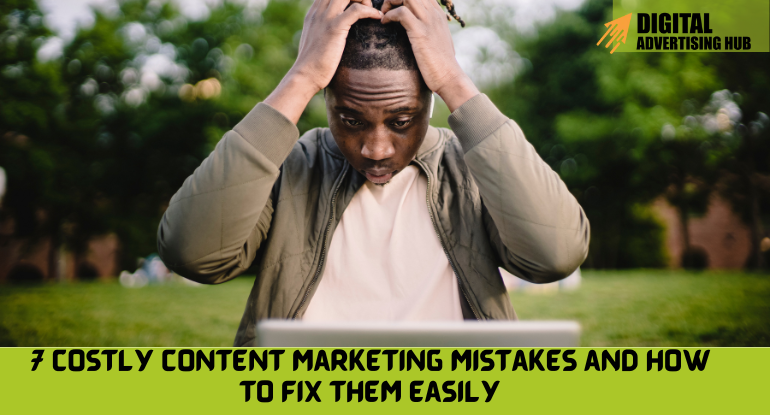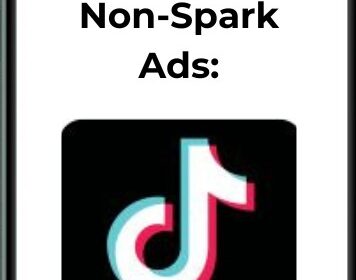Did you know that companies waste an average of 25% of their content marketing budget due to avoidable mistakes? Shocking, right?
Content marketing is a powerful tool for businesses in today’s digital age. It allows you to connect with your audience, establish your brand as an expert, and ultimately drive sales and conversions. However creating a winning content strategy requires more than just churning out blog posts and social media updates.
Many businesses fall victim to common pitfalls that hinder the effectiveness of their content marketing efforts. By recognizing and avoiding these 7 critical content marketing mistakes, you can ensure your content resonates with your target audience, achieves your marketing goals, and delivers a strong return on investment (ROI).
7 Common Content Marketing Mistakes
#1. Lack of Direction (No Goals or Target Audience)

Imagine this: You’re driving down a highway at night, headlights on, but with no specific destination in mind. You might end up somewhere, eventually, but it will likely be a far cry from your desired outcome.
This is exactly what happens with content marketing when you lack clear goals and a well-defined target audience. You might be creating content that looks good and sounds interesting, but if it doesn’t resonate with a specific group of people or serves a particular purpose, it will struggle to achieve any meaningful results.
For instance, a software company creates blog posts solely focused on the technical specifications of its product, failing to address the common pain points and goals of its target audience (busy marketing managers).
In another scenario, an e-commerce store consistently publishes generic fashion articles without considering the specific demographics, interests, and fashion preferences of its ideal customer.
These scenarios highlight the importance of setting specific goals from the outset. Do you want to increase brand awareness, generate leads, drive website traffic, or establish yourself as an industry thought leader?
Once you have your goals in mind, you need to understand who you’re trying to reach. Creating detailed buyer personas that outline your target audience’s demographics, challenges, and online behavior is crucial. By understanding your ideal customer, you can tailor your content to their specific needs and interests, significantly increasing the chances of engagement and achieving your desired outcomes.
#2. Inconsistent Posting
Ever subscribed to a YouTuber who uploads sporadically, leaving you hanging for weeks on end with no new content? Frustrating, right? The same principle applies to content marketing.
Inconsistent posting is a recipe for audience indifference. When you fail to deliver content regularly, you risk losing the momentum you’ve built and allowing your audience to drift away.
Think of it this way: Consistent content creation is like building a bridge with your audience. Each piece of content you publish acts as a stepping stone, steadily guiding them toward your brand and fostering a sense of connection. However, large gaps between content releases create breaks in this bridge, making it difficult for your audience to stay engaged and invested in your brand story.

Imagine a fitness influencer who uploads workout videos once a month. While the content itself might be high quality, the inconsistency makes it difficult for followers to stay motivated and committed to their fitness goals.
The key to overcoming this hurdle is to establish a consistent content calendar. Plan your content in advance, whether it’s daily, weekly, or bi-weekly, and stick to your schedule as much as possible.
This allows your audience to anticipate new content and develop a habit of regularly checking in for your latest offerings. Consistency fosters trust and builds a loyal following around your brand.
#3. Self-Serving Content (All About You, Not Your Audience)
Imagine attending a networking event where someone only talks about themselves and their achievements. You’d likely walk away feeling bored and unimportant, right?
This is what happens with content marketing when you solely focus on promoting yourself and your brand without offering any value to your audience.
While self-promotion is a natural part of the game, bombarding your audience with constant sales pitches and product features is a surefire way to turn them off.
The key is to prioritize providing valuable content that caters to your audience’s needs and interests. Here’s how:
- Focus on solving their problems: Address the common challenges and pain points your target audience faces. Offer solutions, tips, and actionable advice that helps them overcome these obstacles.
- Educate and inform: Become a trusted resource by sharing industry insights, trends, and valuable knowledge relevant to your audience.
- Entertain and engage: Don’t be afraid to inject some personality and humor into your content. Use storytelling, interactive elements, or visually appealing content to capture and hold your audience’s attention.
By prioritizing value over self-promotion, you build trust and credibility with your audience. They’ll perceive you as a helpful expert, increasing their receptiveness to your brand message and ultimately driving conversions.
#4. Ignoring SEO (Search Engine Blindness)
Imagine you’ve opened a fantastic new restaurant in a hidden alleyway, with delicious food and impeccable service. But if no one knows it exists, how many customers will you attract?
This is the predicament you face with content marketing when you neglect Search Engine Optimization (SEO). SEO essentially involves optimizing your content to rank higher in search engine results pages (SERPs) like Google.

In today’s digital landscape, most people discover content through search engines. So, if your content isn’t optimized for relevant keywords and search queries, it’s like having a hidden restaurant – potential customers simply won’t find it.
Here’s how SEO plays a crucial role in content marketing:
#1. Increased Visibility: By incorporating relevant keywords and optimizing your content structure, you ensure your target audience can easily discover your content through search engines.
#2. Organic Traffic: Ranking higher in search results translates to attracting a wider audience organically, without relying solely on paid advertising.
#3. Targeted Reach: SEO allows you to target specific keywords related to your niche and industry, ensuring your content reaches the people actively searching for information you offer.
By incorporating basic SEO practices like keyword research, on-page optimization, and building backlinks, you can significantly improve the discoverability of your content and attract a wider audience through organic search. Remember, good content deserves to be seen, and SEO serves as the key to unlocking its full potential.
#5. Islanded Content (No Promotion or Sharing)
Imagine crafting a beautiful sandcastle on the beach, only to leave it hidden behind a giant sand dune. While the castle itself might be impressive, without actively showcasing it, few people will ever appreciate your work.
The same principle applies to content marketing when you fail to promote and share your content across relevant channels. Creating high-quality content is just one piece of the puzzle. To truly maximize its impact, you need to actively distribute it and get it in front of your target audience.
Why content promotion is crucial:
#1. Limited Reach: Simply publishing content on your website isn’t enough. Most people won’t stumble upon it organically.
#2. Increased Engagement: Promoting your content through social media, email marketing, and other channels sparks conversations, encourages interaction, and boosts audience engagement.
#3. Building Brand Awareness: Consistent content promotion keeps your brand at the forefront of your audience’s mind, solidifying your position as a thought leader in your industry.
There are various effective ways to promote your content:
#1. Social media sharing: Share your content on relevant social media platforms like Facebook, Twitter, or Instagram. Utilize relevant hashtags and engage with your audience in the comments section.
#2. Email marketing: Include snippets of your content in your email newsletters and encourage subscribers to visit your website for the full article or video.
#3. Influencer marketing: Partner with relevant influencers in your niche to promote your content to their audience.
By implementing a strategic content promotion plan, you can break out of your content island and ensure your valuable content reaches the people who will benefit from it most. Remember, creating great content is essential, but actively promoting it unlocks its true potential for audience engagement and brand growth.
#6. Underestimating Analytics (Blind to Performance)
Imagine playing a game but having no idea of the score. How can you truly measure your progress or identify areas for improvement?
This is akin to neglecting website analytics in content marketing. While creating fantastic content is crucial, tracking and analyzing its performance is equally important.
Website analytics tools like Google Analytics provide valuable data and insights that reveal how your audience interacts with your content.
Ignoring this data is like driving a car blindfolded – you might be going somewhere, but you have no idea how effective your journey is.
Here’s how website analytics empower informed content marketing decisions:
#1. Understanding Audience Engagement: Metrics like website traffic, bounce rate, and time spent on the page provide insights into how effectively your content is capturing and holding your audience’s attention.
#2. Identifying Content Performance: Analyzing data like content shares, social media engagement, and conversions helps you understand which content pieces resonate most with your audience and deliver the desired results.
#3. Optimizing Your Strategy: Data insights can reveal areas for improvement. You can identify topics that underperform and adjust your content strategy to cater to your audience’s preferences.
For instance, a content creator might publish a blog post expecting high engagement, but website analytics reveal a concerningly high bounce rate (users leaving the page quickly). This indicates the content might not be addressing the audience’s needs or might be poorly structured.
By actively monitoring and analyzing your content’s performance, you gain valuable insights that empower you to:
#1. Refine your content strategy: Focus on creating content that resonates with your audience and achieves your marketing goals.
#2. Improve content quality: Address any shortcomings in your content structure, information value, or user experience.
#3. Allocate resources effectively: Invest more time and effort into content formats and topics that demonstrably yield positive results.
Remember, data is your friend in content marketing. Utilize website analytics to gain a clear understanding of your audience’s behavior and continuously optimize your content strategy for maximum impact.
#7. Failing to Adapt (Ignoring Trends and Audience Feedback)
Imagine a world where fashion trends never changed, and music remained stuck in the same era. Things would get pretty stale, right?
The same principle applies to content marketing. Neglecting to adapt to evolving trends and audience preferences can render your content strategy stagnant and ineffective over time.
Here’s why staying adaptable is crucial:
#1. Shifting Audience Preferences: Consumer interests and online behavior constantly evolve. What resonated with your audience a year ago might not hold their attention today.
#2. Emerging Industry Trends: New technologies, social media platforms, and content formats emerge frequently. Staying informed about these trends allows you to incorporate them into your strategy and keep your content feeling fresh and relevant.
#3. Valuable Audience Feedback: Actively seeking feedback from your audience through comments, surveys, or social media interactions allows you to gain valuable insights into their preferences and tailor your content accordingly.
Here are some ways to stay adaptable in content marketing:
#1. Stay informed about industry trends: Follow industry publications, attend conferences, and network with other content creators to stay abreast of the latest developments.
#2. Monitor audience engagement: Analyze website analytics and social media metrics to identify content formats and topics that resonate most with your audience.
#3. Actively seek feedback: Encourage audience interaction through comments sections, polls, or Q&A sessions. This allows you to directly understand their preferences and address any concerns.
By remaining adaptable and responsive to change, you ensure your content marketing strategy stays relevant, continues to resonate with your audience, and effectively achieves your goals in the ever-evolving digital landscape.
Remember, the key to success in content marketing lies in continuous learning, embracing new trends, and actively incorporating audience feedback into your approach.
Conclusion
In today’s competitive digital landscape, content marketing remains a powerful tool for businesses to connect with their audience, establish brand authority, and drive conversions. However, avoiding common pitfalls is essential to maximize the effectiveness of your content marketing efforts.
We’ve explored 7 critical mistakes to steer clear of. By avoiding these mistakes and implementing the strategies discussed, you can craft a content marketing strategy that resonates with your target audience, achieves your marketing goals, and positions your brand for long-term success.
Ready to take your content marketing to the next level?
- Study our free guide: 7 Essential Content Marketing Frameworks to Boost Lead Generation and Content Marketing Essential for Online Business
- Subscribe to our newsletter: Receive exclusive content marketing tips and industry insights delivered straight to your inbox.
- Leave a comment below: Share your thoughts on the biggest content marketing challenges you face and how you’re overcoming them.
By taking action and continuously optimizing your approach, you can unlock the true potential of content marketing and achieve remarkable results.










